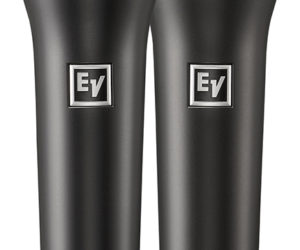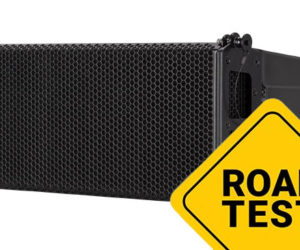The just-introduced CP Series of compact powered loudspeakers from QSC are available in 8- (CP8) and 12-inch (CP12) versions, both with a 1.4-inch compression driver.
The components are driven by a class D amplifier stated to deliver peak power of 800 watts (LF) and 200 watts (HF). One-touch preset DSP contours are also provided for the most common applications.
Both models include a stage monitor angle and can be pole-mounted as well as yoke-mounted via M8 attachment points. Available accessories include carrying tote, outdoor cover and quick-connect yoke mount.
The two-way models basically differ in terms of size and coverage angle. The CP8 incorporates an 8-inch woofer, has stated axisymmetric (conical) dispersion of 90 degrees and frequency response of 56 Hz – 20 kHz. The larger CP 12 sports a 12-inch woofer, axisymmetric dispersion of 75 degrees, and frequency response of 49 Hz – 20 kHz.
Both models share the same DSP features and connections. The rear of the cabinet provides a combo XLR/TRS line input channel with gain control, along with a combo XLR/TRS mic/line input with gain control. Both channels have signal LED lights, and the mic/line channel also offers a Mic Boost button that selects mic level (+25 dB) for the input. In addition, an 1/8-inch 3.5 mm TRS jack fosters connection of music players.
A male XLR Mix output sends all three inputs downstream for connection to another cabinet. A power LED shows that the unit is powered up and a limiter LED lets the user know that the incoming signal has hit the DSP limiter.
The DSP Contour rotary knob provides selection of optimized presets, including Default, EXT Sub, Dance, Dance EXT Sub, Floor Monitor and Speech. A power switch and IEC power cable connector complete the facilities.

The enclosures are made of black polypropylene with an 18-gauge powder-coated steel grille. The CP12 measures 20.3 x 13.8 x 12.7 inches (H x W x D) and weighs 30.3 pounds, while the CP8 checks in at 16.2 x 10.7 x 10.1 inches and weighs 21 pounds. A molded plastic handle on the top of the cabinets makes transportation easy.
Form & Function
As I unboxed one of the two CP8s that QSC provided for this evaluation, the first thing I noticed was the full front grille, which I prefer because it lends a more professional look. Overall, these cabinets look very sharp. The plastic handle on top is large and comfortable, working well with my big hands wearing gloves.
Many folks seem to prefer loudspeakers with 12- or 15-inch woofers for “speaker on a stick” applications, while my company often tends to side with smaller models with 8- to 10-inch cones. They perform very well for corporate events with mainly speech programming joined by playback/background music, and from an aesthetic standpoint, we prefer less conspicuous models.
The CP8 is perfect for many of our primary events because it’s miniscule and lightweight but still able to deliver enough low-end for music playback. And when the application is supporting a band or bass-heavy music tracks, we can simply add subwoofers.
On the test bench, I quickly wired up the loudspeaker and ran a few of my favorite test tracks through it. The controls on the rear panel are well labeled and even a novice can make sense of the DSP without having to consult the manual.
The CP8 has a surprisingly amount of low-frequency output for such a small box, and an overall pleasing sonic signature. The default DSP setting is “flat” and the EXT Sub setting rolls off the bottom for use with an external sub.
While there are no subs in the CP Series lineup as of yet, QSC has plenty of models that will do the trick, including the KS212C dual 12-inch cardioid-pattern model that I evaluated earlier this year.
The Dance EQ setting seems, at least to my ear, to provide the response of a typical “smiley face” curve that appeals to many DJs (and listeners), boosting both the lows and highs. It turns the CP8 into a thumping little box that is ideal for low- to medium-volume playback applications.








